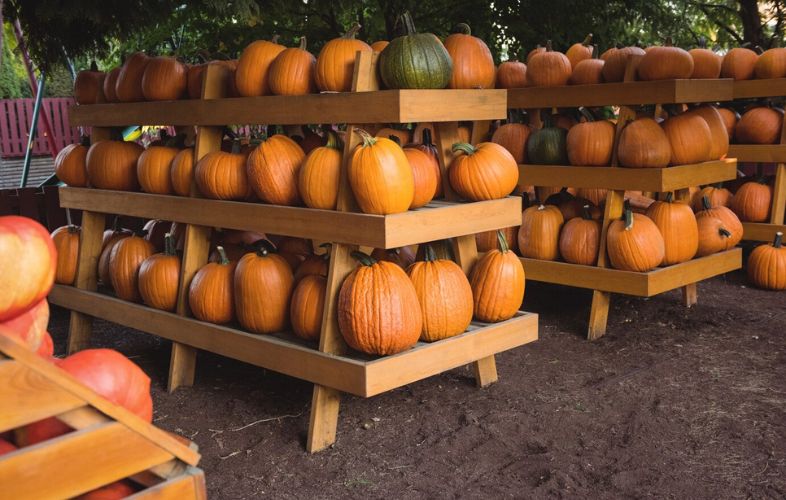Welcome to our comprehensive guide on the “10 Best Tips for Pumpkin Harvesting and Storage.” As autumn approaches, the joy of harvesting pumpkins fills the air. Whether you’re a seasoned gardener or a novice enthusiast, optimizing your pumpkin harvest and storage process is key to enjoying the fruits of your labor throughout the season.
In this article, we’ve curated essential insights and expert tips to ensure your pumpkin bounty remains fresh, flavorful, and long-lasting. From the field to your storage, let’s explore the best practices for preserving your pumpkins with care.
1. Optimal Harvesting Time

The key to a successful pumpkin harvest lies in timing. Wait until the pumpkin has achieved its full color potential and the rind has hardened. Generally occurring in late September to early October, this period signifies the peak ripeness for most pumpkin varieties. A ripe pumpkin not only offers better flavor but also ensures a longer shelf life during storage. To determine readiness, gently press your fingernail into the skin – if it leaves a mark without puncturing, it’s ready for harvest.
2. Cut, Don’t Twist
When harvesting pumpkins, it’s crucial to use the proper technique to avoid damage. Instead of twisting the pumpkin off the vine, use a sharp knife or pruning shears to make a clean cut, leaving a few inches of stem attached. This method prevents tearing and reduces the risk of rot, as a intact stem helps to seal the pumpkin’s flesh, minimizing exposure to potential pathogens.
Also Read: Pumpkin Gardening in Different Climate Zones
3. Cure Before Storage
After harvesting, allow your pumpkins to cure before storing them. Curing involves placing the pumpkins in a warm, dry area for about 10 to 14 days. This process toughens the skin, enhances flavor, and promotes the healing of any cuts or bruises acquired during harvest. Proper curing significantly improves the longevity of your pumpkins in storage and ensures they remain in optimal condition for an extended period.
4. Choose the Right Storage Location
Selecting an appropriate storage location is paramount for preserving your pumpkins. Opt for a cool, dry place with good ventilation. Ideally, the temperature should range between 50-55°F (10-13°C). Avoid storing pumpkins in overly humid or warm areas, as this can accelerate decay. Furthermore, elevate the pumpkins off the ground using pallets or boards to prevent moisture absorption and reduce the risk of rot.
5. Regularly Inspect for Decay

To maintain the quality of your stored pumpkins, perform regular inspections. Check for any signs of decay such as mold, soft spots, or discoloration. Promptly remove any affected pumpkins to prevent the spread of decay to the entire batch. This proactive approach ensures that your remaining pumpkins stay fresh and ready for culinary or decorative use throughout the season.
6. Avoid Sun Exposure
Sunlight can hasten the deterioration of pumpkins. Store them in a dark or shaded area to shield them from direct sunlight. Exposure to sunlight can lead to premature ripening, causing the pumpkins to soften and deteriorate quickly. By keeping them in a cool, dark environment, you’ll maintain their firmness and quality for an extended period.
7. Rotate Pumpkins Regularly
Prevent flat spots and uneven ripening by periodically rotating your stored pumpkins. Every few weeks, gently turn each pumpkin to a different position. This practice ensures that all sides receive equal ventilation and minimizes the risk of developing soft spots due to prolonged pressure on one area.
8. Handle with Care
When moving or handling pumpkins, do so with care. Rough handling can lead to bruising or cuts, making the pumpkins more susceptible to decay. Lift them using the base or, if necessary, support the bottom with both hands. Treating your pumpkins with gentle care at every stage, from harvest to storage, contributes significantly to their overall quality and longevity.
9. Store Only Healthy Pumpkins
Ensure that you only store pumpkins that are in good health. Damaged or bruised pumpkins are more likely to decay quickly and can compromise the condition of the entire stored batch. Prioritize healthy, unblemished pumpkins for storage to maximize their longevity and maintain the quality of your harvest.
Also Read: Pumpkin spice latte recipes at home
10. Embrace Creative Storage Solutions

Explore creative storage solutions to optimize space and organization. Utilize crates, bins, or even old wooden pallets to create a well-ventilated storage area. Additionally, consider labeling each pumpkin with the harvest date to facilitate easy identification and rotation. Implementing organized storage practices not only enhances the preservation of your pumpkins but also makes retrieval and use more convenient when the time comes.
Mastering these ten tips for pumpkin harvesting and storage ensures that your autumn harvest remains fresh, vibrant, and ready for a variety of culinary and decorative purposes throughout the season. By combining proper harvesting techniques with strategic storage practices, you’ll maximize the longevity and quality of your pumpkin bounty, allowing you to savor the essence of fall well into the winter months. Happy harvesting!
Conclusion
Mastering the art of pumpkin harvesting and storage is a rewarding endeavor that enhances your autumn experience. By implementing these 10 expert tips, you’ll not only enjoy a bountiful harvest but also extend the lifespan of your pumpkins, ensuring their freshness for delightful recipes and festive decorations. Embrace the season with confidence, and let the rich colors and flavors of your carefully harvested and stored pumpkins enhance the spirit of fall. Happy harvesting!
FAQs
The optimal time to harvest pumpkins is when the fruit reaches full color and the rind hardens. Typically, this occurs in late September to early October.
Store pumpkins in a cool, dry place with good ventilation, ideally around 50-55°F (10-13°C). Ensure they are lifted off the ground to prevent rotting, and regularly check for any signs of decay to promptly remove affected pumpkins.

Leave a Reply